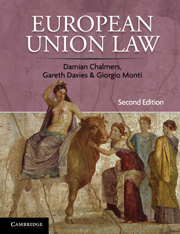Book contents
- Frontmatter
- Contents
- Map
- Preface
- Abbreviations
- Table of Cases
- Table of Treaties, Instruments and Legislation
- Table of Equivalents
- Electronic Working Paper Series
- 1 European Integration and the Treaty on European Union
- 2 The EU Institutions
- 3 Union Law-making
- 4 The EU Judicial Order
- 5 The Authority of EU Law
- 6 Fundamental Rights
- 7 Rights and Remedies in National Courts
- 8 Infringement Proceedings
- 9 Governance
- 10 Judicial Review
- 11 EU citizenship
- 12 EU Law and Non-EU Nationals
- 13 Equal Opportunities Law and Policy
- 14 EU Criminal Law
- 15 External Relations
- 16 The Internal Market
- 17 Economic and Monetary Union
- 18 The Free Movement of Goods
- 19 The Free Movement of Services
- 20 The Pursuit of an Occupation in Another Member State
- 21 Trade Restrictions and Public Goods
- 22 EU Competition Law: Function and Enforcement
- 23 Antitrust and Monopolies
- 24 State Regulation and EU Competition Law
- Index
21 - Trade Restrictions and Public Goods
- Frontmatter
- Contents
- Map
- Preface
- Abbreviations
- Table of Cases
- Table of Treaties, Instruments and Legislation
- Table of Equivalents
- Electronic Working Paper Series
- 1 European Integration and the Treaty on European Union
- 2 The EU Institutions
- 3 Union Law-making
- 4 The EU Judicial Order
- 5 The Authority of EU Law
- 6 Fundamental Rights
- 7 Rights and Remedies in National Courts
- 8 Infringement Proceedings
- 9 Governance
- 10 Judicial Review
- 11 EU citizenship
- 12 EU Law and Non-EU Nationals
- 13 Equal Opportunities Law and Policy
- 14 EU Criminal Law
- 15 External Relations
- 16 The Internal Market
- 17 Economic and Monetary Union
- 18 The Free Movement of Goods
- 19 The Free Movement of Services
- 20 The Pursuit of an Occupation in Another Member State
- 21 Trade Restrictions and Public Goods
- 22 EU Competition Law: Function and Enforcement
- 23 Antitrust and Monopolies
- 24 State Regulation and EU Competition Law
- Index
Summary
INTRODUCTION
This chapter is about derogations from free movement, and their review by the Court of Justice. These derogations exist to protect important national interests – public goods – but they can also be used to disguise protectionism, which is why they are usually quite strictly reviewed.
Section 2 provides an introduction to the themes and context of the Treaty derogations. These Articles are at the heart of one of the most important current debates: whether globalisation unavoidably threatens non-economic interests and values, or whether reconciliation or compromise is possible. The Court uses a range of ideas and principles, from transparency to a margin of appreciation, in its search for the right approach.
Section 3 addresses the range of public goods which the Treaty protects. The explicit derogations are brief and limited, but the Court has extended them with its invention of the mandatory requirement, or the general public interest objective. The range of justifications which may be relied upon to restrict movement is now very broad, and only protectionist reasons, or purely economic reasons, have been excluded. This latter category is problematic: the distinction between an economic and a non-economic interest is often not clear. For example, protecting national budgets protects the health of public institutions, and so also protects interests such as public health and public security.
- Type
- Chapter
- Information
- European Union LawCases and Materials, pp. 870 - 907Publisher: Cambridge University PressPrint publication year: 2010

